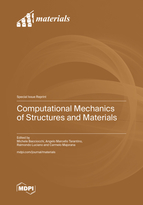Computational Mechanics of Structures and Materials
A special issue of Materials (ISSN 1996-1944). This special issue belongs to the section "Materials Simulation and Design".
Deadline for manuscript submissions: closed (20 March 2023) | Viewed by 31574
Special Issue Editors
Interests: finite element methods; structural mechanics; plates and beams; numerical analysis; laminated composites; multiphase composites; innovative composite materials; functionally graded materials; carbon nanotubes; non-local theories
Special Issues, Collections and Topics in MDPI journals
Interests: viscoelasticity; fracture mechanics and dynamic propagation of cracks; bifurcation theory, nonlinear dynamics, and chaos; piezoelasticity and magnetoelasticity; contact problems; equilibrium, bifurcation, and stability in finite elasticity; fiber-reinforced concretes and earthquake engineering
Special Issues, Collections and Topics in MDPI journals
Interests: computational mechanics of structures and of materials and specifically unilateral problems; computational analysis of masonry structures; computational mechanics of composite materials; finite element method; computational micromechanics; nonlinear and non-local theories
Special Issues, Collections and Topics in MDPI journals
Interests: dynamic stability of structural systems; thermo-hydro-mechanical constitutive behavior of cementitious materials at high temperatures; coupled multi-physics formulations for multi-phase, porous media in unsaturated regime; high-performance concrete characterization and modeling; large strain formulation; plasticity of building materials
Special Issues, Collections and Topics in MDPI journals
Special Issue Information
Dear Colleagues,
The huge number of recently published research papers on computational and numerical methods for solving various structural problems proves that this topic has great potential, and the further advancements that can be accomplished are still numerous.
Following this preliminary statement, the main aim of this Special Issue is to collect innovative investigations dealing with accurate, reliable, and effective numerical approaches in the field of both structural mechanics and mechanics of materials.
Numerical analysis focused on the development of finite element or finite-element-based methods for innovative problems is welcomed. Likewise, different computational techniques involving the solution of both strong and weak formulations for those problems that require the development of numerical methods to get approximate but accurate solutions are gladly accepted.
In any circumstance, authors are strongly invited to emphasize the novelty of their approaches, highlighting the improvements with respect to the existing literature. The proposed numerical tools and analyses must be validated. Their accuracy shall be discussed as well. Much attention will also be dedicated to the numerical investigations of advanced and innovative materials, as well as multiscale analyses, employed in many engineering fields, such as civil, mechanical, and aerospace engineering.
The topics of interest include but are not limited to:
- Development of numerical techniques for structures and materials;
- Numerical analyses;
- Finite element and finite-element-based methods;
- Computational methods for beams, plates, and shells;
- Numerical studies of laminates and functionally graded materials;
- Numerical analyses of advanced and innovative composite materials;
- Numerical approaches for the mechanical analysis of nanostructures;
- Nonlocal elasticity;
- Numerical studies in finite elasticity;
- FEM applications for elasticity problems;
- Linear and nonlinear behaviors of structures;
- Mechanical characterization of innovative constituents;
- Validation of experimental procedures and constitutive laws.
Dr. Michele Bacciocchi
Prof. Dr. Angelo Marcello Tarantino
Prof. Dr. Raimondo Luciano
Prof. Dr. Carmelo Majorana
Guest Editors
Manuscript Submission Information
Manuscripts should be submitted online at www.mdpi.com by registering and logging in to this website. Once you are registered, click here to go to the submission form. Manuscripts can be submitted until the deadline. All submissions that pass pre-check are peer-reviewed. Accepted papers will be published continuously in the journal (as soon as accepted) and will be listed together on the special issue website. Research articles, review articles as well as short communications are invited. For planned papers, a title and short abstract (about 100 words) can be sent to the Editorial Office for announcement on this website.
Submitted manuscripts should not have been published previously, nor be under consideration for publication elsewhere (except conference proceedings papers). All manuscripts are thoroughly refereed through a single-blind peer-review process. A guide for authors and other relevant information for submission of manuscripts is available on the Instructions for Authors page. Materials is an international peer-reviewed open access semimonthly journal published by MDPI.
Please visit the Instructions for Authors page before submitting a manuscript. The Article Processing Charge (APC) for publication in this open access journal is 2600 CHF (Swiss Francs). Submitted papers should be well formatted and use good English. Authors may use MDPI's English editing service prior to publication or during author revisions.
Keywords
- computational mechanics
- numerical methods
- advanced and innovative constituents
- solids mechanics
- structural analyses
- FE and FE-based methods









